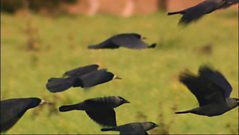
Swarming sopranos
Soprano pipistrelles return to the roost in droves early in the morning.
It's 4.30am and Mike Dilger is hoping to see several hundred mammals returning to a house in Hampshire. These are soprano pipstrelle bats, which gather in their hundreds in maternal roosts when it's time to breed. First thing in the morning they put on a show known as swarming. You can even film them on a home-movie camera, if it has an infra-red setting. The bats can be seen via the camera swirling round the roof of the house. Mike meets Alison Racey of the Bat Conservation Trust, who records the bats' calls with a bat detector. Soprano pipistrelles' calls have a frequency of 55 kHz. The common pipistrelle calls at 45 kHz and the Nathusius's pipistrelle is below 40 kHz. Their echolocation calls get faster and faster as they home in on an insect. A maternity roost is where the females gather together to have their babies once a year. They usually have one baby each, in June or July. Baby bats are called pups. This roost is an excellent location becasue there is plenty of food - lots of insects. Mike really likes bats because he hates midges and a pipistrelle can eat around 3,000 midges in a night.
Duration:
This clip is from
Featured in...
![]()
Βι¶ΉΤΌΕΔ Nature
Be captivated, informed and inspired by the world's wildlife.
More clips from Nature's Top 40
-
![]()
Dawn and dusk spectacular—Episode 3
Duration: 04:06
-
![]()
Neon nymphomaniacs—Episode 1
Duration: 04:44
-
![]()
Back - and big—Episode 5
Duration: 05:06
-
![]()
Puffin paradise—Episode 6
Duration: 03:24






